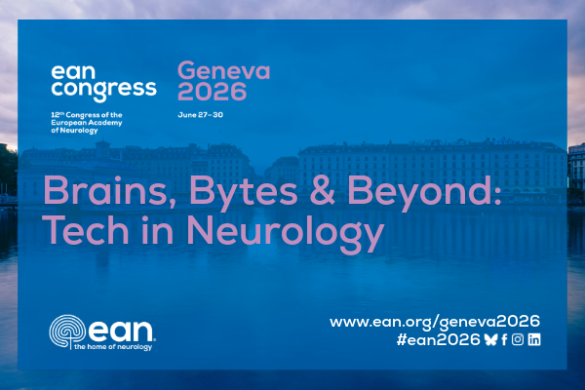by Elena Moro
For October 2018, we have selected two papers. The first is: Adams D, Gonzales-Duarte A, O’Riordan WD, et al. Patisiran, an RNAi therapeutic, for hereditary transthyretin amyloidosis.(APOLLO trial). NEJM 2018;179:11-21. The second is: Benson MD, M Waddington-Cruz, JL Berk, et al. Inotersen treatment for patients with hereditary transthyretin amyloidosis. (NEURO-TTR trial) NEJM 2018;179:22-31.
Hereditary transthyretin amyloidosis is a rare autosomal dominant disorder in which mutations of the gene for transthyretin protein (TTR) induce systemic deposition of amyloid. This accumulation causes progressive peripheral polyneuropathy, cardiomyopathy, nephropathy, and dysfunction in other organs. Because the main production of systemic transthyretin protein is in the liver, liver transplantation has been the treatment goal standard. However, there are several limitations related to this therapy and to other treatments which became more recently available (tafamidis, diflunisal, small molecules that stabilize the circulating tetrameric form of transthyretin and slow disease progression).
Two new chemically modified oligonucleotides, patisiran and inotersen, have been tested in two double-blind, randomized, phase 3 multicenter trials. These drugs reduce the amyloid deposition by similar mechanisms of action. Patisiran reduces the production of both the wild-type and mutant transthyretin RNA transcripts by binding the 3’ untranslated region of transthyretin mRNA (RNA interference therapeutic agent). Inotersen is an antisense oligonugleotide inhibitor that binding TTR mRNA activates its degradation by RNAase H thus reducing both the wild-type and mutant transthyretin RNA transcripts.
In the APOLLO study, Adams and colleagues investigated the effects of patisiran versus placebo in genetically confirmed hereditary transthyretin amyloidosis patients with peripheral neuropathy, and no liver transplant. Primary outcome was change in the modified Neuropathy Impairment Score+7 (mNIS+7) from baseline to 18 months. Among the secondary outcomes there were the Norfolk Quality of Life-Diabetic Neuropathy (QOL-DN) questionnaire., motor strength, and gait speed. Treatment was given intravenously every 3 weeks. A total of 225 patients (148 randomized to patisiran, and 77 to placebo) were enrolled at 44 centers in 19 countries within about two years. Overall, at the end point, the patisiran group showed a significant improvement in the mNIS+7 compared to placebo (-6.0 ± 1.7 versus 28.0 ± 2.6; p<0.001). Quality of life and gait speed also improved significantly compared to placebo.
The overall incidence of adverse events did not differ between groups.
In the NEURO-TTR trial, Benson and colleagues studied the efficacy of inotersen versus placebo in patients coming from 24 centers in 10 countries. Included patients had genetically confirmed hereditary transthyretin amyloidosis with peripheral neuropathy, biopsy-confirmed amyloid deposits, no liver transplant or heart failure. Over three years, a total of 172 patients were randomized to receive inotersen (112) or placebo (60), administered subcutaneously once a week for 65 weeks. Primary outcomes were changes in a slightly different version of the mNIS+7 and the Norfolk QOL-DN questionnaire. About 22% of the patents with inotersen and 13% of the patents with placebo discontinued the study. At 15 months, both the mNIS+7 and the QOL-DN score (-19.7 points and -11.7 points difference, respectively; p<0.001) were improved compared to baseline for the inotersen group versus placebo. Concerning safety, one patient with inotersen died of intracranial hemorrhage due to thrombocytopenia. Fifty-four % of patients treated with inotersen had reduced platelets count. Moreover, glomerulonephritis occurred in three inotersen patients.
From the EAN Task Force for Rare Diseases and the EAN Neuropathy Panel, we have the pleasure to have comments from:
Prof. Dr. Davide Pareyson (Department of Clinical Neurosciences, Fondazione IRCCS, Istituto Neurologico Carlo Besta, Milan, Italy) and Prof. Dr. Peter Van den Bergh (Neuromuscular Reference Centre, Department of Neurology, University Hospital Saint-Luc, Brussels, Belgium)
These two trials represent a major breakthrough in the treatment of this still lethal disorder, as liver transplantation has limited indications and the TTR stabilizers tafamidis and diflunisal are able to slow but not halt the disease progression. Instead, patisiran and inotersen had a major impact on disease course, resulting in stabilization/improvement (inotersen) or improvement (patisiran) of the disease scores according to the primary outcome measure mNIS+7 in 36 and 56% of patients and in quality of life in 50 and 51% of cases, respectively. Remarkably, both treatments proved effective irrespective of the TTR mutation (Val30Met and non-Val30Met), disease severity, age of onset (early and late onset forms), and presence of cardiomyopathy. Moreover, the difference with the placebo groups was significant for several secondary measures. The treatments were well tolerated, particularly for patisiran, which produced diarrhea, peripheral edema. and infusion-related reaction as the most frequent side effects, whereas more caution is needed with inotersen, which requires monitoring of platelet count and renal function to prevent and monitor adverse effects occurrence. There are still open questions about their use in the long-term treatment, including the consequences of low TTR levels, and those of the continuing TTR production in the eye and in the brain.
The EMA has started the procedures for marketing the compounds. It is fundamental that these drugs, which are life-saving, will soon be accessible throughout Europe to patients at an accessible cost.
The other nominees for the October 2018 Paper of the month are:
- Tawbi HA, Forsyth PA, Algazi A, et al. Combined nivolumab and ipilimumab in melanoma metastatic to the brain. NEJM 2018; 379:722-730. Efficacy and safety of nivolumab abd ipilimumab were assessed in 94 patients with melanoma and at least one untreated brain metastasis without neurological symptoms. At a mean follow-up of 14 months, the majority (57%) of patients showed a clinical intracranial response, with 26% complete clinical benefit, 30% partial benefit, and 2% stable disease.
- Peter I, Dubinsky M, Bressman S, et al. Anti-tumor necrosis factor therapy and incidence of Parkinson’s disease among patients with inflammatory bowel disease. JAMA Neurol 2018:75;939-946. In this retrospective study, the authors investigated the role of anti-tumor necrosis factor (anti-TNF) therapy as risk factor to develop Parkinson’s disease (PD) in patients with inflammatory bowel disease with or without anti-TNF treatment. Overall, a higher risk to develop PD was found in the 144,018 patients included. However, anti-TNF exposure was associated with decreased risk to develop PD.
- Tsivgoulis G, Katsanos AH, Mavridis D, et al. Intravenous thrombolysis for ischemic stroke patients on dual antiplatelets. Ann Neurol 2018:84;89-97. The author investigated the effects of dual antiplatelets pre-stroke treatment or no treatment in patients who underwent intravenous thrombolysis for acute ischemic stroke. Data coming from prospectively collected data over a 7-year period of time showed that symptomatic intracerebral hemorrhage, 3-month mortality rate, and functional outcome did not differ between patients without antiplatelet treatment and dual platelet pretreatment history.
- Vatzaki E, Straus S, Dogne J-M, Burgos JG, Girard T, Martelletti P. Latest clinical recommendation on valproate use for migraine prophylaxis in women of childbearing age: overview from European Medicines Agency and European Headache Federation. J Headache and Pain 2018;19:68. org/10.1186/s10194-018-0898-3. The adverse events induced by valproate to treat migraine in women of childbearing age are well known. For this reasons several recommendations have been implemented in Europe to limit valproate use. In this paper, the authors reviewed the effects of valproate in children exposed in utero, the effectiveness of measures and recommendations from 2014, the 2018 updates recommendations, and practical material for physicians.












